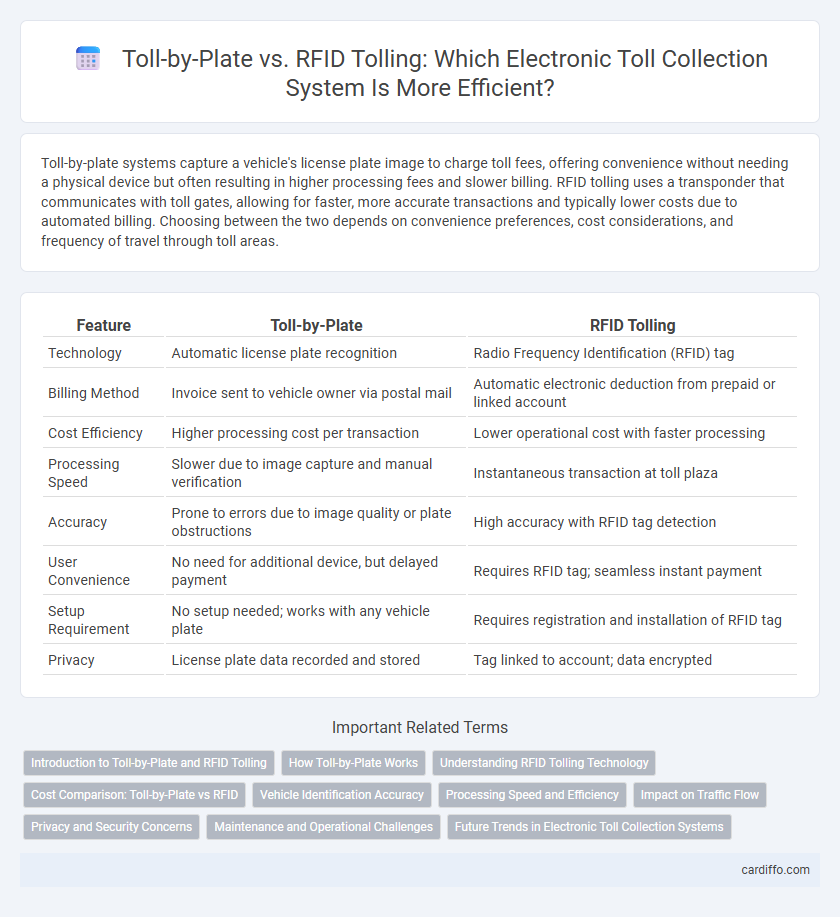Toll-by-plate systems capture a vehicle's license plate image to charge toll fees, offering convenience without needing a physical device but often resulting in higher processing fees and slower billing. RFID tolling uses a transponder that communicates with toll gates, allowing for faster, more accurate transactions and typically lower costs due to automated billing. Choosing between the two depends on convenience preferences, cost considerations, and frequency of travel through toll areas.
Table of Comparison
| Feature | Toll-by-Plate | RFID Tolling |
|---|---|---|
| Technology | Automatic license plate recognition | Radio Frequency Identification (RFID) tag |
| Billing Method | Invoice sent to vehicle owner via postal mail | Automatic electronic deduction from prepaid or linked account |
| Cost Efficiency | Higher processing cost per transaction | Lower operational cost with faster processing |
| Processing Speed | Slower due to image capture and manual verification | Instantaneous transaction at toll plaza |
| Accuracy | Prone to errors due to image quality or plate obstructions | High accuracy with RFID tag detection |
| User Convenience | No need for additional device, but delayed payment | Requires RFID tag; seamless instant payment |
| Setup Requirement | No setup needed; works with any vehicle plate | Requires registration and installation of RFID tag |
| Privacy | License plate data recorded and stored | Tag linked to account; data encrypted |
Introduction to Toll-by-Plate and RFID Tolling
Toll-by-plate systems use automated cameras to capture license plate images, enabling billing through mail without requiring electronic transponders. RFID tolling relies on radio-frequency identification tags mounted on vehicles to facilitate instant, contactless toll payments via dedicated readers. Both systems aim to streamline toll collection, but RFID offers faster processing and reduced administrative costs compared to toll-by-plate.
How Toll-by-Plate Works
Toll-by-plate systems capture a vehicle's license plate using high-resolution cameras as the vehicle passes through the toll point, automatically generating a toll invoice sent to the registered owner. This method eliminates the need for on-vehicle transponders, making it accessible for all drivers but often incurs higher processing fees due to image recognition and billing administrative costs. The technology relies on advanced optical character recognition (OCR) software to accurately identify license plates, ensuring efficient toll collection without requiring electronic RFID tags.
Understanding RFID Tolling Technology
RFID tolling technology uses radio-frequency identification tags mounted on vehicles, enabling automatic toll payments without stopping at toll booths. This system increases traffic flow efficiency by eliminating manual transactions and reducing congestion compared to toll-by-plate methods, which rely on image capture and subsequent billing. RFID readers detect these tags at high speeds, providing real-time transaction processing and minimizing errors associated with license plate recognition.
Cost Comparison: Toll-by-Plate vs RFID
Toll-by-plate systems incur higher costs due to manual license plate image processing and added administrative fees, often leading to increased toll charges compared to RFID tolling. RFID tolling employs electronic transponders that enable automatic, real-time deduction of toll fees, reducing operational expenses and passing savings to drivers. Average RFID tag costs range from $5 to $20, while toll-by-plate fees can include extra surcharges up to 30% above standard toll rates.
Vehicle Identification Accuracy
Toll-by-plate systems rely on high-resolution cameras and license plate recognition software to identify vehicles, but they can face challenges like plate occlusion, dirty plates, or poor lighting, leading to potential misreads or fines. RFID tolling uses electronic transponders attached to vehicles, enabling near-perfect identification accuracy through radio frequency signals, regardless of weather or visibility conditions. While RFID offers superior vehicle identification accuracy and faster processing, it requires drivers to have active transponders, whereas toll-by-plate can charge any vehicle without additional equipment.
Processing Speed and Efficiency
Toll-by-plate systems rely on license plate recognition technology, which requires image capture, data processing, and billing, resulting in slower processing speeds and higher operational costs compared to RFID tolling. RFID tolling uses radio-frequency identification tags for instantaneous vehicle detection and seamless transaction processing, significantly enhancing traffic flow and reducing congestion. Enhanced efficiency of RFID tolling supports higher throughput on toll roads, minimizing delays and improving overall travel experience.
Impact on Traffic Flow
Toll-by-plate systems slow traffic flow due to the need for license plate recognition and subsequent billing, often causing congestion at toll plazas. RFID tolling enables seamless vehicle passage with electronic tag scanning, significantly reducing wait times and minimizing traffic delays. Implementing RFID tolling improves overall traffic efficiency and decreases congestion on busy roadways.
Privacy and Security Concerns
Toll-by-plate systems capture and store vehicle license plate images, raising privacy concerns due to potential misuse or unauthorized access to personal data. RFID tolling uses radio frequency identification tags, offering enhanced security through encrypted data transmission but posing risks if RFID signals are intercepted or cloned. Both methods require robust data protection measures to safeguard user information against cyber threats and unauthorized tracking.
Maintenance and Operational Challenges
Toll-by-plate systems require frequent manual image reviews and higher maintenance costs due to camera upkeep and data processing errors, increasing operational challenges. RFID tolling minimizes maintenance demands with automated transponder readings that reduce the need for image processing and error correction. Ensuring reliable RFID tag functionality and managing transponder distribution are critical for sustaining efficient toll operations.
Future Trends in Electronic Toll Collection Systems
Future trends in electronic toll collection systems emphasize the integration of RFID technology for faster, more accurate vehicle identification and reduced congestion compared to toll-by-plate methods. Enhanced data analytics and machine learning optimize traffic flow and dynamic pricing strategies, while increased adoption of vehicle-to-infrastructure (V2I) communication supports seamless toll transactions and improved road safety. Emerging standards focus on interoperability across regions to facilitate nationwide electronic tolling networks, boosting efficiency and user convenience.
Toll-by-plate vs RFID tolling Infographic

 cardiffo.com
cardiffo.com